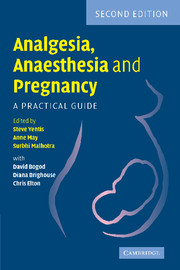Book contents
- Frontmatter
- Contents
- List of contributors
- Preface
- SECTION 1 PRECONCEPTION AND CONCEPTION
- SECTION 2 PREGNANCY
- I Procedures in early/mid-pregnancy
- II Normal pregnancy and delivery
- III Operative delivery and third stage
- IV Anaesthetic complications
- V Problems confined to obstetrics
- VI Problems not confined to obstetrics
- VII The neonate
- SECTION 3 PUERPERIUM AND AFTER
- SECTION 4 ORGANISATIONAL ASPECTS
- Index
III - Operative delivery and third stage
Published online by Cambridge University Press: 10 November 2010
- Frontmatter
- Contents
- List of contributors
- Preface
- SECTION 1 PRECONCEPTION AND CONCEPTION
- SECTION 2 PREGNANCY
- I Procedures in early/mid-pregnancy
- II Normal pregnancy and delivery
- III Operative delivery and third stage
- IV Anaesthetic complications
- V Problems confined to obstetrics
- VI Problems not confined to obstetrics
- VII The neonate
- SECTION 3 PUERPERIUM AND AFTER
- SECTION 4 ORGANISATIONAL ASPECTS
- Index
Summary
INSTRUMENTAL DELIVERY
Vaginal delivery may be facilitated by the use of forceps or a suction cup (ventouse). Forceps deliveries can be divided into outlet, low, mid-cavity or high (rotational), although high forceps deliveries are in decline in many centres in favour of Caesarean section.
In the UK, approximately 10% of deliveries are performed with forceps or ventouse, but the figure is very variable in different units and is greatly affected by individual policies with respect to the maximum allowable duration of the second stage, the use of Syntocinon to augment contractions and criteria for Caesarean section.
In general, instrumental delivery can be indicated by maternal factors (exhaustion, failure to descend, illness precluding Valsalva manoeuvre) or fetal factors (fetal distress, prematurity). The commonest indication is prolongation of the second stage, often defined as longer than 2 hours for a primigravida (3 hours with an effective epidural), or one hour for a multigravida (2 hours with an epidural).
Problems/special considerations
Analgesia
Analgesia produced by low-dose epidural solutions may be adequate for low-outlet (‘life-out’) forceps or ventouse delivery, but mid- or high-cavity forceps delivery requires dense surgical anaesthesia. A good pelvic block is essential, and the perineum should be tested before inserting the instrument. For anything other than an outlet forceps or ventouse, the sensory block should extend up to T10.
- Type
- Chapter
- Information
- Analgesia, Anaesthesia and PregnancyA Practical Guide, pp. 80 - 109Publisher: Cambridge University PressPrint publication year: 2007



